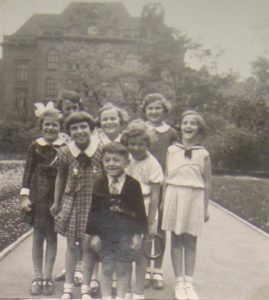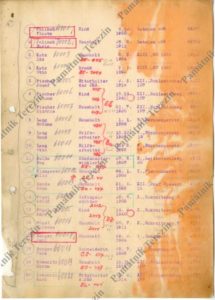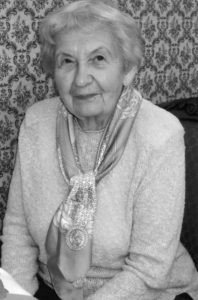(June 27, 1927 – November 5, 2017)

Eva with her classmates from a Karlín school (second right), first half of the 20th century, Eva Štichová´s private archive.
Eva was born in 1927 in Nový Bohumín as Eva Beldová. At the age of two she moved with her parents to Prague, while the family still maintained close ties with their relatives in the Těšín district and Silesia. During her vacations Eva would often come back to stay with her granny.
Eva´s parents hailed from an area known for its profoundly religious Jewish community, which was also reflected in the Belda family life. In Prague they maintained a kosher household, the family used to go to a synagogue for major holidays. Her father worked in the Bromografia company publishing art books and photographs. Eva attended a Czech school, her friends being Czech children without any regard for their religious conviction. However, later on she had to leave the school because of her Jewish origin and since then she befriended mostly Jewish youngsters who shared a similar fate with her. In 1941 she began working in a factory manufacturing condensers. It was there that she first came into contact with the underground resistance movement in which she became involved.
She received an order to a transport to the Terezín Ghetto in the fall of 1942. She left for Terezín alone even though her father and the rest of the family volunteered to join the transport to keep them all together.
In the Ghetto Eva lived in the girls´ home L 410, working in a vegetable garden, locally known as ”Crete“. Here, too, she was engaged in the underground work, being in touch with people who greatly influenced her future opinions. These were, for instance, Irena Krausová, Truda Sekaninová, František Grauss and many others.
Eva´s parents and her elder sister Helga were deported to Terezín in early March 1943. But already in the fall of 1943 her parents were put on the list for a transport to the East. They perished in the Auschwitz-Birkenau concentration camp while Eva, at that time, had not the faintest idea of their fate.
In the summer of 1944 Eva worked for some three months as an assistant to Friedl Dicker-Brandejs in her art classes. Eva would prepare teaching aids or write headings for children´s drawings. Watching Friedl teach her children proved to be an unforgettable experience for Eva.
Later on Eva was also assigned to a transport to the East, her summons came in the fall of 1944. She left the Terezín Ghetto in a transport designated En on October 4, 1944. Eva always recollected her journey in this transport with a very heavy heart since she had travelled with adults but also with some 500 children, most of them orphans. Eva was very lucky to pass the selection in the Auschwitz-Birkenau concentration camp and she was soon sent to work in Freiberg. She was in a factory manufacturing wings for jet fighters. With the approaching battlefront the Nazis tried to transfer Eva and her fellow inmates to Flossenbürg. But that camp had already been liberated by the US Army before Eva´s transport from Freiberg could get there. A long and stressful journey, which eventually ended in the Mauthausen concentration camp, awaited the women prisoners, all of them in a sorry state. Eventually, Eva lived to see the camp´s liberation by the Americans on May 5, 1945.
Eva was seriously ill during the first days of peace. Fortunately for her, she was treated by a Czech inmate – surgeon professor Podlaha who operated on her, thus saving her life. Eva returned to Prague on May 19, 1945 but she did not find any member of her family. Later on, one of her cousins and her sister Helga came back. However, Eva refused to return to her parental home and then managed to get small a bedsit. Trying to make up for the lost time she enrolled in the Women´s Teacher Training Institute in Prague. This school predetermined her professional career until the end of her working life.
For Eva Mauthausen did not spell only the end of her hardships experienced at the end of the war; the place also brought into her life a ray of hope and eventually enough strength to live on. While in the camp she met another man, aksi a prisoner, Dr. Zdeněk Štich whom she married later in 1945. Her husband´s family cordially received then 18-year Eva who started her ”normal“ life. Eva´s sister also got married and left for the United States. Eva applied herself to bringing up her two children and spent many happy years side by side her beloved husband. In addition to her family, she derived a lot of pleasure from teaching her pupils, a career that spanned nearly three decades.
After the foundation of the Terezín Initiative Eva Štichová became involved in the work of this association. She co-authored a reader called Cesta – cíl neznámý (Journey – Destination Unknown, Academia Prague 1995) and she made very good use of her teaching experience also in the past few decades during countless debates with pupils and students at schools, in the Terezín Memorial and elsewhere.
Eva Štichová´s enormous strength lay in her indomitable life optimism and her laughter which she shared during meetings with her audiences – pupils, students and adults alike. This image of her shall always stay imprinted in our memories.
Se





